“Lay Me By The Shore”, Director David Findley talks about
filming in 65mm |
Read more at in70mm.com The 70mm Newsletter |
| Written by: Thomas Hauerslev. David Findley interviewed on a rainy afternoon at the Dagmar Cinema, Copenhagen, Wednesday 22. March 2023 | Date: 31.03.2023 |
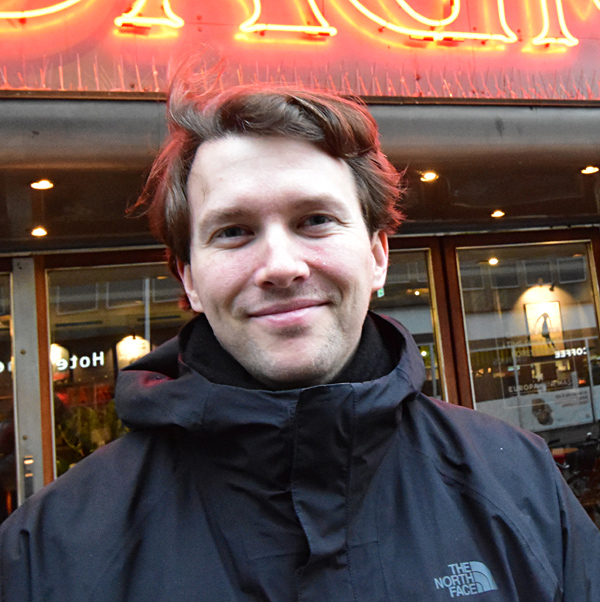 David
Findlay (1991) is Canadian born and temporarily based in Copenhagen, during
winter 22/23. Picture: Thomas Hauerslev David
Findlay (1991) is Canadian born and temporarily based in Copenhagen, during
winter 22/23. Picture: Thomas HauerslevThomas Hauerslev: David, you already have done a lot of interviews where you talk about the film and the talent, so I will focus on the 65mm. As far as I can see, that has not been really mentioned in depth anywhere. Tell me about why you have chosen to use 65mm in some parts of your short film? David Findlay: How to begin? I suppose you start by shooting on Super 8, and then you go 16mm, and then you finally step up to 35. Let's try 4-perf. now, let's scan it and see the resolution. And for me, the fascination with film has never been the grain, and it has never been -- kind of what people call the the organic nature of it. It's rather just like the definition of the rendering of colors and of skin tones. It's just the way that it feels. Just kind of natural. And every time you shoot digital ... all we're doing in post production is trying to mimic ... trying to get it to look like those films. I've been told by different producers, colleagues and peers, "Oh, David, you're you're being romantic about film". I go "Well, I'm pretty romantic about movies". You know what I mean? And so, yeah, I can assume that and say that, and then with 65mm, it was always, one day the right project will come along. And with “Lay Me By the Shore” it seemed like the right one. Because I wanted to tell a story about a young boy coming to terms with his best friend's passing. The same with this piece of music "Lay me by the shore", the lyrics, the perspective of the title. The way I wanted to shoot it was in a very subtle way, from the perspective of this recently-departed friend, and without making any ghost story, anything paranormal, fantastical, sci-fi or anything like that. I wanted that presence at times to be felt. For me, it was about how to place the camera and how to convey that there is a presence. That this character isn't alone. For me, when those moments were most felt, that's when I wanted to shoot on the larger format, which I felt sort of gives off this great sense of lucidity, you know? Like 65mm has ... no brain at all, ... which I love, and it feels like a window, or like a portal. In our case, for our film, kind of from the window, maybe from the beyond, on which to view our world or something like that. So conceptionally that was the idea, to use this large format in certain heightened moments. And also, there's something exciting about using a format that's usually used for action or epic or travel [productions] to tell an intimate human story. And also pairing the casting of young non-actors and wanting to attain a really nice sense of naturalism. How they are, how they behave, and how they tell us their story. But then to point a hyper-cinematic lens at them, to me that felt like something I hadn't seen before. You know, often, if it's real people or first time actors, people will want to lean into that and do a cinéma vérité style, and put the camera on their shoulders and make it feel gritty or something like that. To me the opposite was true. I was more excited to capture these performances and this story, and as I said, through this heightened kind of filmic lens. I think the impetus for that, was thinking back on that time of my life. I haven't lived a very dramatic life, but I can remember when I was a kid where everything you feel, you feel like a bit more intensely because it's new and it's more ... anyways, maybe I was just really sensitive. If I was riding my bike home from school, listening to music and something had happened or whatever, how big or small that happened to be, in my mind, I was in this big music video or cinematic film. That's my life. You know, and all these things; school, this girl that didn't talk to me, whatever it might be. It felt huge. That's how I wanted this film to kind of depict it. So that was the idea. THa: Large format film is important to you, because 65mm gets people more involved in the your story. Would that be correct? David Findlay: Yeah, I guess that's a part of it. I shoot certain projects on digital. I think it's a different tool for a different thing, for a different approach. I think part of the film was muted. [It's] about grand emotions that are kind of muted by everyday moments in life, and my idea with what I wanted to tell, and how to tell it, was to highlight this sort of small poetry of everyday life. These small short scenes that by themselves aren't necessarily so evocative or telling, but when you slowly add them all up together, they paint a really nice, really nuanced portrait. Film, 35 or 65, to me was the perfect tool to tell that story. To highlight this, the sadness and beauty, and the beauty and sadness and to access ... I think, would feel more easily. And it's not a cognitive thing, it's an emotional thing of being able to access these sort of in-between notes of the emotional piano if you will. [It's] just like being able to access literally, more shades of grey, or something like that in your story, and to support that visually. |
More in 70mm reading: “Lay Me By The Shore” Short Film in 35mm and 65mm "Daughter of Dismay" with Director James Quinn 70mm, Cinerama, IMAX and Cinemas in Canda in70mm.com Interview & People in70mm.com's Library Presented on the big screen in 7OMM Peripheral Vision, Scopes, Dimensions and Panoramas |
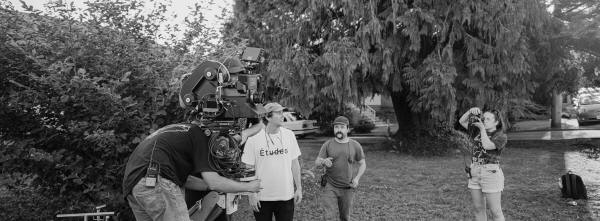 Fries
8-perf
65mm camera with staff and crew. Picture by Sam Gilling, courtesy Director David Findlay Fries
8-perf
65mm camera with staff and crew. Picture by Sam Gilling, courtesy Director David FindlayTHa: Tell me about the 65mm camera you used and the 65mm film, and how this came about. What is the story? David Findlay: Basically, the story goes [like this], the cinematographer on the film, Evan Prosofsky, he's from Alberta in Canada. That's where "The Revenant" (2015) was shot, and "The Revenant" was supposed to shoot on 65mm. They did a bunch of tests and very quickly they said "This doesn't work, we can't really pull it off". And so, Evan, I think, bought a shitload of film, or all of their film, at a discounted rate, and stored all of it in his parents basement. So he's been sitting on a ton of 65mm film for a long time. Plus he has a bunch of different 65mm cameras. He was just keen and eager to shoot, and use it. He's been slowly working on all sorts of different 65mm projects. I contacted him pretty early on, telling him I want to shoot this on film. Certain scenes on 65 and he was really, really excited to bring out his camera, and make it happen. His camera is a Fries 865, 8-perf 65mm camera. It's a huge ... the thing is just enormous, and it's heavy and it's loud. And what's tricky is, well ok, if we're doing longer takes and you're on a 35mm [production] you just change the magazine quickly. Changing the magazine on this thing takes 10-15 plus minutes. It's like "we have X amount left in the magazine. Do we change the magazine, or do we try to speed up this next take?". So it comes with a lot of technical or practical challenges that you need to consider. But, it was cool. And also, it's interesting when he turns it on, it takes ... you hear it of course, and it takes a while to get it up to speed. You can't be like "Roll. Action!". It's more like "Roll [pause] ............ OK, now Action!" [laughing]. You can feel the cost of it as well, and that was another challenge, which I welcome. Shooting on film, especially on this format, with limited [funds], you can't make a million takes. And with young actors, or non-actors, you don't want to over-rehearse so that when you shoot it feels lifeless, but you also don't want to improvise. So, it's finding this balance and being clever with how and when to shoot with these kids. Which is a challenge. But like I said, a totally welcome challenge and really fun as well. THa: It was shot by Evan Prosofsky in 65mm 8-perf in Vancouver. How much of the final movie is from 65mm? David Findlay: I think it was about 25% of the film which was shot in 65mm. |
|
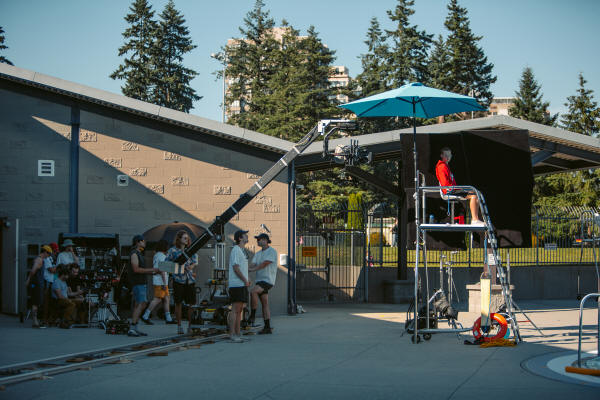 35mm
Panavision Millennium XL II camera
with staff and crew. Picture courtesy Director David Findlay 35mm
Panavision Millennium XL II camera
with staff and crew. Picture courtesy Director David FindlayTHa: One would assume it is expensive to shoot in 65mm - does that present any restrictions or limitations, if you want to make several takes? Can you afford it? Is that in your mindset? David Findlay: I knew we made sure we had more than enough film. You don't want to get to the point where we run out. I know it's going to cost something, but if I'm not getting the performance I'm still going to keep going, and not get the feeling of "Oh well, we have to move on because I need to save raw stock". Being from Canada, I was lucky to get all sorts of grants (National Film Board Arts Council) and money to make this film. I'm just grateful for that. It's all sorts of great producers who were happy to jump in. Like the advice I give to really young film maker(s) sometimes. Go shoot something in Super 8, if only for forcing you to sit down and think "What shots do I need, for sure, to tell this story"? Whether it's a music video or a really short film. You can do it with digital. But with film, it's a bit more precise and a bit more immediate, the sense of, "OK, I want to do this shot, but do I need this shot or, why do I want to do this shot"? Just really forcing you to be a bit more deliberate in your approach. I had done it with 16 and with 35 a few times. With 65 it was kind of cranked up, "Why do I want to shoot this, this way, and why do I want to shoot this in 65"? Again, just kind of asserting that to me, it was really useful. But it is true, it was expensive. We did everything with FotoKem in LA, both the 35 and the 65 was done in their telecine for the editing. And then the 35 was scanned at 4K and the 65 was scanned at 8K. And obviously doing the telecine to piece the film together. It is kind of the practical economic thing, and it still looks perfectly fine to be able to work and put it together. You have to be economical. I think people appreciate it when you loop them in to your project really early on, and that's what I have done. For example with Panavision, since I was in film school, a year before shooting my end-of-year film on 16mm for the first time, I went to the Panavison office and told them about the project, and they just appreciated that, that I was thinking about it so early on. So they gave me a free camera package nine years ago. And then I did the same thing with FotoKem, really early on. We'll be shooting in more than a year away. We will shoot on 65mm film. Let's get on a call and just present this project. It's the duality of saying "Me and my team, we know what we're doing. We are really professional, but we're also kids. We're broke. Help"! I mean, how does this work? You do not want to end up on your knees. The reality is, we have support from this person, this entity and this financial backing. Also, we are a short film and you just always end up stretching the budget as much as you can, and calling for friends and favours as much as you can. THa: Everyone ended up working for free? David: Kind of, more or less. Let's make it fair, it's tricky with those things. I think it's about just presenting the project to them, and why you want to do it. Helping on some student projects can change their reputation in the business. |
|
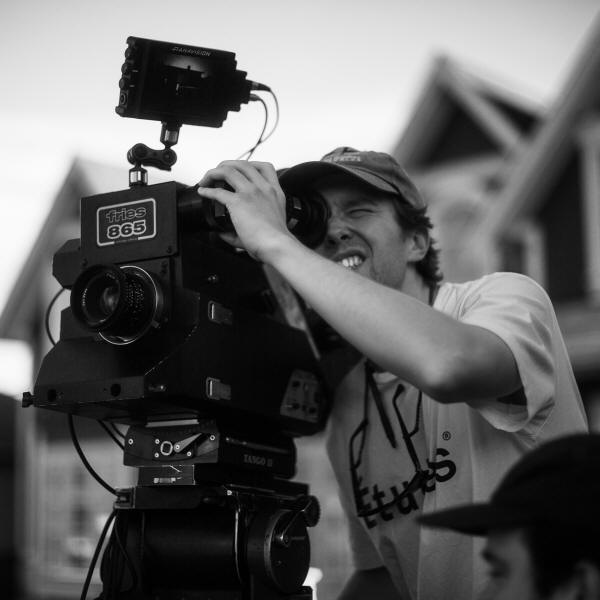 Fries
8-perf
65mm camera and David Findlay. Picture courtesy Director David Findlay Fries
8-perf
65mm camera and David Findlay. Picture courtesy Director David FindlayTHa: What kind of challenges does 65mm present compared to 35mm – if any? David Findlay: Yeah, there were a couple of shots that ... just as a safety ... we did right after also with the 35. The focus puller Jerry, he's worked with Evan and with this camera a lot, but there are certain moves with the really thin depth of field where he's just pulling off the barrel. He doesn't have the usual handset and everything, he's just going by his eyesight. But it is so precise, that it's tricky. He ended up nailing everything. I remember sometimes, just to be totally sure, let's also shoot this take on 35 just to make sure we have it. I think the main thing is how bulky the camera is. You can't put it on your shoulder. Shooting take after take is difficult. We can't shoot dialogue, definitely not inside, and that's OK. I knew that limitation going into it. The main challenge is really just the speed at which we could make changes. If I did want to shoot a dialogue, or a more conventional scene, it would be tricky to shoot take after take. Change magazine. Go again, "Oh, there's not enough"? Change magazine again. "How much short ends do we have?" Or if there's too short a remaining length of film it's worth nothing, because just getting the camera up to speed takes up this much film. So yes, it's not an easy format. It just isn't, but I think the results are totally worth it. Maybe during editing I was happy that it was cool and OK. But honestly, it wasn't until we got the 8K scans of the 65. OK - THIS IS COOL! This is worth it! Then going to Berlin and watching it for the first time on a big screen, it was like, "OK, YES!" [smiling proudly]. I'm glad. THa: Congratulations with the premiere in Berlin, and later at TIFF in Toronto. David Findlay: Thank you. We sent in a rough-cut to Berlin and had no expectations. And then by January 3rd of last year, they said "Congratulations, it's in". Oh my God, I need to finish the film now! [laughing] I had a month to do it. All the edits were almost done, but have to scan all the stuff and time it and everything. Initially it was my ambition to make a 70mm print. I was in touch with the festival about it, but there were all sorts of circumstances because of COVID restrictions, limited capacity, only 35mm, in a different cinema etc. Berlin had to decline a 70 print. "70mm - sorry, but we can't accommodate". Meanwhile we were also in touch with FotoKem, talking to them about how to do the optical track [DATASAT soundtrack negative] and all that stuff. It was going to cost us just more than we could afford. We were also thinking it's not going to be used very much [a 70mm print]. Sadly, but it would be such a great, fun thing to finally to go all the way. But in the given circumstances, we couldn't make it work. We made a 4K DCP, which ended up looking really great as well. THa: That leads to my next point. We have one rule at the 70mm festivals. If it's a 70mm thing, we HAVE to show it in 70mm. People are coming from near and far to watch 70mm - the real thing on a screen. I would love to show your film. David Findlay: Yeah, yeah, I get you. That would be great. I'll have to look into that. That would be wonderful, but it's so damn expensive, it's unfortunate! |
|
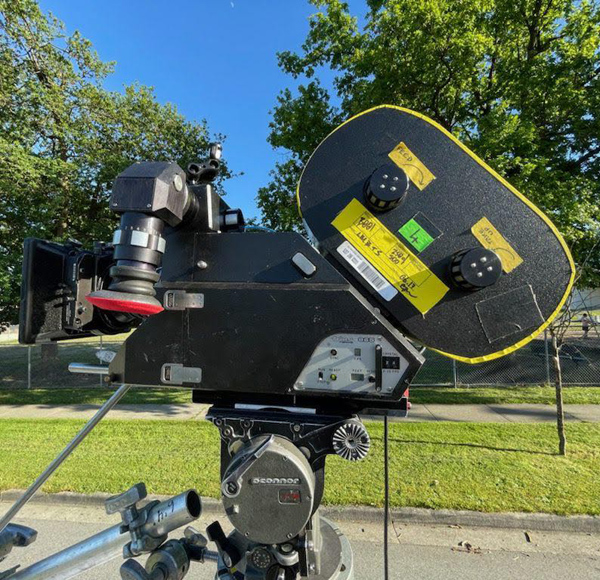 Fries
8-perf 65mm camera. Picture
courtesy Director David Findlay Fries
8-perf 65mm camera. Picture
courtesy Director David FindlayTHa: From my perspective, your film will have a life "in 70mm" for many, many festivals because there are 70mm festivals and screenings in Europe and in the States. There you can just send the print around. I mean that it will be shown to the fans who really appreciate it. David Findlay: That's true. Fans, the people who love it. I know that's a good point. We should look into it more, or perhaps we should resume this conversation again later, because I think I need to make a couple more commercials to be able to finance a 70mm print! THa: The essence of the question is, will there be a 70mm print available for festivals? David Findlay: ... we'll see. I'm just not sure yet. THa: What kind of support did you get from Kodak and Panavison? In your "Thank you" credit you also thanked Mark Magidson, who produced "Baraka" (1991) and "Samsara" (2012) David Findlay: Yeah, that's true. I was on the phone with him. He was lovely. He was one of those people who I called and emailed to kind of say like, "Hey, I'm making this film. I'm crazy. How do I it? What sort of resources, or help, and who do I call to get a deal on scanning, on printing, on the camera"? He was lovely and nice to chat to, and he just pointed me in FotoKem's direction. I spoke to a couple of people at IMAX about the same thing, and they were able to kind of "sweeten the deal" a little bit with FotoKem. Kodak ... I've frequently been in touch with Ann Hubbell out of New York, and she's been helping out, here and there, however she can. She got us at least one extra free roll [of 35mm negative], which was really helpful, and in this case we didn't buy any 65 from there. Evan the DP had it all. Panavision ... Austin out of Vancouver. He's he's been a big supporter of mine and my projects over the years and been a great ally. Obviously we didn't shoot with the Panavision System 65, but we shot with their Millennium XL II with the 35mm 4-perf, which was great. He was able to give us a very, very generous deal on on all those things, which is cool, yeah. THa: 8-perf 65, that's more or less 1,43:1. Did you go for that format specifically because you had the 65mm format 8-perf available? David Findlay: Yeah, my idea was to do 4:3 aspect ratio. I just love the way it renders portraits of faces. There's something a bit timeless [about it]. It is a bit related to photography, of how you photograph things that are dear to you. For me it wasn't about shooting epic landscapes or even the neighbourhood that much, it was about focusing in on characters. And I think by closing the frame a little bit that way, you create a more intimate relationship to the characters, which excites me. I think the 8-perf image was a bit wider when the 8K [scans] came back, and then it was a decision pretty quickly that I had to make like: do I chop the 4:3 35 or do I chop the 65 like this [motions a rectangle with hands, ed]. Ultimately, I think it would have altered more frames in the 35, if I'd opened it laterally. So I decided to keep everything just in the one aspect ratio. I personally don't like when films have different aspect ratios. I want to keep it consistent. Like IMAX movies, "Dune" and all the Christopher Nolan stuff. I love to go see those in IMAX in the biggest possible way, but I don't get it. I don't get why you would do something like that? To me, it's super distracting. If you're doing the IMAX thing, bloody leave it in the thing. Leave it big to me. It's distracting, and takes me out of it. And it makes me notice ... makes me remember that I'm watching a movie, and I wanted to lose myself. I want it to wash over me kind of thing. Yeah, well I get it. I know what they're saying, "OK, now this is epic. Hey everyone, this is going to be epic"! I can guess it, or just make me feel it by itself and like I said, it just takes me out of the film. It makes me notice something about the film. People sometimes ask me "As a filmmaker are you able to watch a movie, or are you always looking at how it's made"?, and I always say when the movie is good, I'm just along for the ride. I'm watching. I'm paying attention to the actors, to the story. That's it. And then I'm going to love rewatching and then going, "Ohh!, OK, how did they make it"? But the first time I see a film, as much as possible I know it's really good if I didn't notice really [any particular technical gimmickry], or any sort of flourishes or technical stuff. It's a quality test. |
|
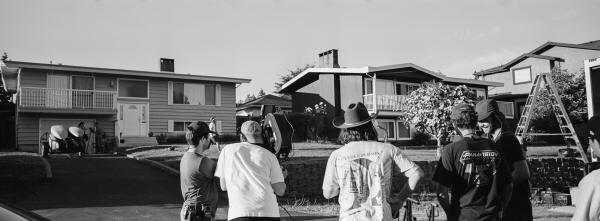 Fries
8-perf 65mm camera with staff
and crew. Picture by Sam Gilling, courtesy Director David Findlay Fries
8-perf 65mm camera with staff
and crew. Picture by Sam Gilling, courtesy Director David FindlayTHa: Future plans - more 65mm? David Findlay: Yes! I don't know when. We're shooting "Lay Me By the Shore", -- the feature film, the expansion, the same story with the same actors -- in a 90 minute version to share that story with a wider audience. The real truth is not a lot of people watch short films, aside from in film festivals and online. That's the big new project, and we're shooting on 35. This time I decided I want to shoot on 3-perf. I feel like I want to just expand the frame and make use of the wider screen. As we speak I'm unsure if we do some 65. I would really like it. I hate that it comes down to money, but it does. If we do end up shooting in 65, it will be for fewer scenes. But if so, I think it would be 15 perf IMAX. I'd love to shoot 3-perf, to have a tiny bit more grain if anything, to have a bigger jump in the transition. Not in aspect ratio though. Keep the same aspect, but to make it feel there's something going on here that feels a bit different, to really highlight those scenes. I think the transition between 4-perf 35 and 8-perf - you know, 65mm, you don't really notice it. I hope that people do pick up on it. That was always my intention. Like any decision that you make in your filmmaking, how does this impact the emotion of the scene, or how people perceive or ingest the scene? You don't need to be a techno-geek to feel something. Even if you don't notice consciously what's going on. By and large, most people can't see it and that's OK. But in order to make that jump be felt even more than it might normally be, shooting 3-perf and then jumping to the absolute largest format possible [would work]. THa: Perhaps old fashioned 5-perf 65mm System 65 from Panavision would work for you? Show it anywhere. 90 minute movie - perfect. Five or six reels of movie and you're good to go in our festival, and then maybe 10-20 additional cinemas in Europe where you can show it in 70 millimeter. David Findley: That's the dream. Yeah, exactly, that's what I want to do. Oh, man, that's crazy. What do you think? What's the future [of 70mm]? |
|
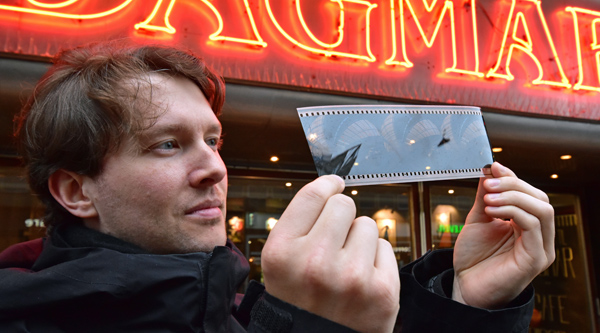 "...
65mm, you don't really notice it. I hope that people feel it. That was
always my intention." Picture: Thomas Hauerslev "...
65mm, you don't really notice it. I hope that people feel it. That was
always my intention." Picture: Thomas HauerslevTHa: Well, it is the format that will not go away. Rumor says it has been dead for many, many years, but 70 millimeter is still here for some odd reason. It will not die, despite the anticipated death of 70mm nearly 55 years ago when "Hello, Dolly!", "Ryan's Daughter" and "Patton" came out. Everyone has been saying "It's too expensive. It's too complicated. It's too ....", whatever. I mean, it has outlived even 35mm film [since digitalisation]. I am as positively surprised as anyone. After "Far and Away", "Baraka", and "Hamlet" and the introduction of digital sound in the early 1990s everyone said "OK, that's it! No more 70mm". And then 20 years later, "Samsara" was photographed in 65mm and "The Master" showed up with actual 70mm prints, which was followed on by films by Branagh, Nolan, Anderson, Tarantino and a few more, who are still using large format - even 15-perf IMAX. I would never have believed that would happen during the lowest doldrums of the mid 1990s. I never expected to see 10 more movies in the following 30 years. But here we are in 2023. That is why we are here today, because you did it too! You are carrying the 65mm torch with "Lay Me By the Shore". David Findley: OK, good. I'm glad to hear that and glad we met. Yeah, super nice. Film enthusiasts -- they're the best. I love a clear picture and images that have depth. It doesn't have to do with the depth of field, but the depth of colors and light. The quality of light and 65 - that is what works really, really well. I don't want grain. I remember when I made my student film, shot on 16, and then scanned it 4K, and then you go "Whoa, cool" - it looks great on your computer. Then at end of year student Film Festival, you project it from film. And it looked GREAT! And then you remember film was always meant to be projected. Even if it is a digital file, once projected, it just looks and feels better. So even a digital 4K file of something that is shot in 35 or 65 - that's the way to do it. Of course obviously adding in the good sound and all the rest. There's something about the actual projection of it, that's not on an LED screen ... THa: Light reflected? David Findley: Yeah. Yeah, it's light bouncing off a white screen. THa: I enjoyed your movie. I enjoyed the subtleties in the focus, and the depth of field. The movement of the camera was so pleasing to see. David Findley: Thank you Thomas. There's barely any dialogue. The film communicates mostly visually I think. THa: My final question, why are you in Denmark these days? David: I had been here [In Copenhagen] a few times and I just love it. And I thought, let's just take a chance. I've been living in Toronto for a while. I'm from Quebec, the French part of Canada. I was kind of tired of that and then just decided to take a risk, and the idea was always to go to Copenhagen from August until April, which is now, and then head back over to Vancouver to shoot "Lay Me By the Shore" the feature film this summer [2023]. So that's the next new big project that's keeping me awake at night. THa: Thank you for your time |
|
| Go: back - top - back issues - news index Updated 21-01-24 |
